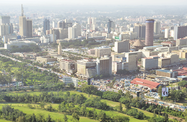A funding boost from the African Development Bank (AfDB) for feasibility studies on Kenya’s Lamu Port development will help advance a key component of the country’s proposed multi-billion-dollar logistics project.

On March 7 the AfDB announced plans to make available a $1.93m grant to fund advisory services and technical support for a full transaction study on the development of Lamu Port. The facility is located 340 km north-east of the Port of Mombasa, which currently serves as Kenya’s primary maritime hub.
Regional gains
The new port represents the cornerstone of a significantly larger infrastructure development, the Lamu Port-South Sudan-Ethiopia Transport (LAPSSET) corridor – a combined road, rail and pipeline network – linking Kenya’s eastern seaboard with its landlocked neighbours. The cost of the total cost of the project has been estimated to be in excess of $24.5bn.
The Lamu Port transaction plan will detail the key factors relating to project financing options, which include defining the feasible transaction structure, funding arrangements and scope, alongside its risks and other factors, according to Benson Thuita, corporate affairs officer for LAPSSET.
Commenting after the AfDB’s announcement, Thuita said that the plan would also outline the investment advantages and bankability of the project. He added that the new port would be instrumental in easing congestion at other hubs in the region, including Kenya’s own Port of Mombasa. The project is also set to benefit from other maritime infrastructure projects already operating in the region, Thuita noted.
“The establishment of such a trans-shipment port at the Lamu site on the Indian Ocean coastline at the time when the Suez Canal is undergoing expansion will also enable the new port to play a significant regional role,” he said.
The throughput of imports via the expanded Suez link to the west and the markets of Asia to the east is proving to be a major draw for investors keen to meet rising demand in expanding regional economies.
However, Lamu Port’s potential as an export hub is also expected to generate interest among industry players eyeing shipments in the other direction, providing increased access to the agricultural and mineral wealth held by states set to be linked to the facility by LAPSSET.
Building connectivity
According to the project’s blueprint, Lamu Port will house 32 berths, with a projected cargo-handling capacity of 13.5m tonnes by 2020, rising to 23.9m tonnes by 2030.
The Kenyan government has already broken ground on three of the port’s berths, with the first set to be operational by the third quarter of 2018, while the second and third are scheduled to be completed by the end of 2020. Along with the roll-out of the first loading facilities, the initial $689m stage of the development includes extensive dredging to create a deepwater basin, land reclamation, road links and construction work.
The government is looking to the private sector to finance the development of the remaining 29 berths and much of the supporting infrastructure. Its plans include a proposed public-private partnership system based on the build-operate-transfer model.
Potential challenges
However, enthusiasm for the LAPSSET development has dampened recently, influenced by the fall in energy prices, instability in South Sudan and competition from another pipeline running through Tanzania.
Aside from reducing potential earnings from the pipeline component of the LAPSSET corridor, weaker oil and gas prices also risk weighing on the broader economies of the upstream states, putting revenue projections under pressure. The conflict in South Sudan could also drive down revenue flows, affecting a potential source of energy shipments.
In the longer term, competition for regional trade is likely to become the main challenge faced by Lamu Port. Ethiopia already has a rail link to Djibouti’s main deepwater port, which has a a container-handling capacity of 2m twenty-foot equivalent units (TEUs), while a $1.6bn pipeline project between the two countries is also under development.
A $3.5bn pipeline agreement between Uganda – another target market for the LAPSSET project – and Tanzania may also impact traffic to Lamu Port.
However, plans to focus on dry cargo and energy, rather than containers, would give Lamu an edge on both Mombasa – which is currently Kenya’s largest maritime facility, and is being developed primarily as a container trans-shipment hub – and the port of Djibouti.


